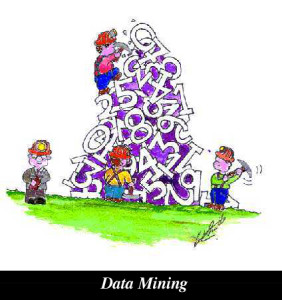This article gives the information of data mining. The analysis becomes more meaningful using Data Mining, as it enables managers to establish relationship between business elements and find out aspects and facts about their business that may not be evident otherwise. Data mining, thus, a is an information analysis tool that involves the automated discovery of patterns and relationship in a data ware house. Data Mining is a new but powerful concept that has started to gain popularity in business Intelligence World. Data Mining aims at extracting at patterns, trends and rues from Data Ware house to evaluate either predict or scour proposed business logics, which in turn will development competitiveness improve profits and transform business process.
Data Mining can be defined in the following manner “Data Mining or Knowledge Discovery Database (KDD), as it is also known is the non-trivial removal of understood, beforehand unknown and potentially useful information from data”. The second definition of Data Mining “is the process of discovering meaningful information new correlation patterns and trends by shifting through large amount of data stored in repositories using recognition technique as well as statistical and mathematical techniques ”. It derives number of techniques, such as clustering, data summarization, classification, finding dependency network, analyzing changes and detecting anomalies. KDD: Knowledge Discovery in Database is the process of identifying a access, potentially useful and unique understandable structure of data. The process involves selecting or sampling data, from a data warehouse, cleaning it or pre-processing it, hand forming or reducing structure and then evaluated the derived structure.
Data Mining is the search for the relationship and global patterns that exit in large database but are hidden among vast amount of data, such as relationship between patient data and their medical diagnosis. This relationship represents valuable knowledge about the database, and the object in the database, if the database is faithful mirror of the real world registered by database. Data Mining refers to “using a variety of techniques to identify nuggets of information or decision making knowledge in the database and extracting these in such a way that they can be put to use in areas such as decision support, prediction, future imaginations and cost estimation”. The data is often voluminous but it as low valued and no direct use can be made to it. It is the hidden information in the data that is useful.
What Does Data Mining Do?
Data mining do the following results:
- Discovering unknown associations. Such association can be found when one event can be co- related to another event that seems completely unrelated.
- Sequence, where one event leads to another later event.
- Identify patterns that lead to subdivision or new organization of data.
- Finding out facts previously not known (even clustering).
- Future thinking or simply discovering patterns in the data that can lead to prediction in about the future.
Data Mining Application:
- Data Trends
- Hardware Trends
- Network Trends
- Scientific computing Business Trends
In short Data Mining is the process of discovering meaningful, new correlation patterns and trends by shifting through large amount of data stored in repositories using pattern reorganization techniques as well as statistical and mathematical techniques.
